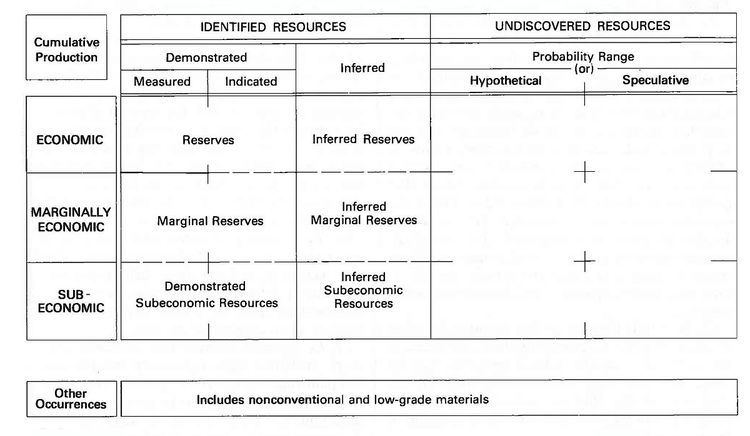 | ||
Mineral resource classification is the classification of mineral resources based on an increasing level of geological knowledge and confidence.
Mineral deposits can be classified as:
In common mining terminology , an "ore deposit" by definition must have an 'ore reserve', and may or may not have additional 'resources'.
Classification, because it is an economic function, is governed by statutes, regulations and industry best practice norms. There are several classification schemes worldwide, however the Canadian CIM classification (see NI 43-101), the Australasian Joint Ore Reserves Committee Code (JORC Code), the South African Code for the Reporting of Mineral Resources and Mineral Reserves (SAMREC) and the “chessboard” classification scheme of mineral deposits by H. G. Dill are the general standards.
Mineral reserves and Ore Reserves
Mineral reserves are resources known to be economically feasible for extraction. Reserves are either Probable Reserves or Proved Reserves.
A Probable Ore Reserve is the part of indicated, and in some circumstances, measured mineral resources that can be mined in an economically viable fashion. It includes diluting material and allowances for losses which may occur when the material is mined. A Probable Ore Reserve has a lower level of confidence than a Proved Ore Reserve but is of sufficient quality to serve as the basis for decision on the development of deposit.
A Proved Ore Reserve is the part of Measured resources that can be mined in an economically viable fashion. It includes diluting materials and allowances for losses which occur when the material is mined.
A Proved Ore Reserve represents the highest confidence category of reserve estimate. The style of mineralization or other factors could mean that Proved Ore Reserves are not achievable in some deposits.
Generally the conversion of resources into reserves requires the application of various modifying factors, including:
